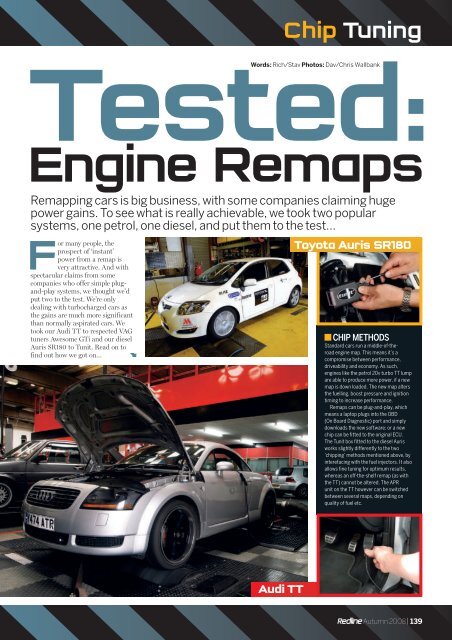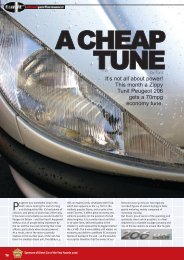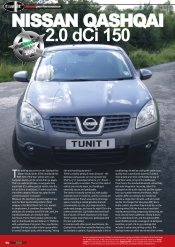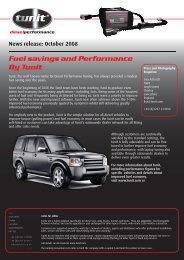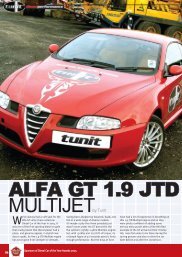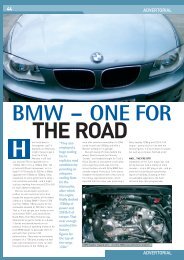Create successful ePaper yourself
Turn your PDF publications into a flip-book with our unique Google optimized e-Paper software.
Chip Tuning<br />
Tested:<br />
Words: Rich/Stav Photos: Dav/Chris Wallbank<br />
Engine Remaps<br />
Remapping cars is big business, with some companies claiming huge<br />
power gains. To see what is really achievable, we took two popular<br />
systems, one petrol, one diesel, and put them to the test…<br />
For many people, the<br />
prospect of ‘instant’<br />
power from a remap is<br />
very attractive. And with<br />
spectacular claims from some<br />
companies who offer simple plugand-play<br />
systems, we thought we’d<br />
put two to the test. We’re only<br />
dealing with turbocharged cars as<br />
the gains are much more significant<br />
than normally aspirated cars. We<br />
took our Audi TT to respected VAG<br />
tuners Awesome GTi and our diesel<br />
<strong>Auris</strong> <strong>SR180</strong> to <strong>Tunit</strong>. Read on to<br />
find out how we got on…<br />
<strong>Toyota</strong> <strong>Auris</strong> <strong>SR180</strong><br />
CHIP METHODS<br />
Standard cars run a middle-of-theroad<br />
engine map. This means it’s a<br />
compromise between performance,<br />
driveability and economy. As such,<br />
engines like the petrol 20v turbo TT lump<br />
are able to produce more power, if a new<br />
map is down loaded. The new map alters<br />
the fuelling, boost pressure and ignition<br />
timing to increase performance.<br />
Remaps can be plug-and-play, which<br />
means a laptop plugs into the OBD<br />
(On Board Diagnostic) port and simply<br />
downloads the new software; or a new<br />
chip can be fitted to the original ECU.<br />
The <strong>Tunit</strong> box fitted to the diesel <strong>Auris</strong><br />
works slightly differently to the two<br />
‘chipping’ methods mentioned above, by<br />
interefacing with the fuel injectors. It also<br />
allows fine tuning for optimum results,<br />
whereas an off-the-shelf remap (as with<br />
the TT) cannot be altered. The APR<br />
unit on the TT however can be switched<br />
between several maps, depending on<br />
quality of fuel etc.<br />
Audi TT<br />
Autumn 2008 | 139
increase. So the mid-range is much<br />
improved – which is exactly where<br />
you need it for safer for overtaking,<br />
rather than some crazy top end<br />
you’ll never fully use on the road. So<br />
our advice is to look at the overall<br />
picture, rather than just being<br />
seduced by claimed peak power<br />
figures. Obviously we only tested<br />
one system and each car is different,<br />
but it does give you an idea of what<br />
to expect.<br />
ON THE ROAD<br />
As soon as we drove the TT it was<br />
a different beast. The extra torque<br />
was immediately apparent and you<br />
no longer had to thrash the car to<br />
get any performance out of it. With<br />
as much as 56bhp at certain parts of<br />
the rev range, the car felt an awful<br />
lot quicker.<br />
PERFORMANCE<br />
TESTING<br />
We strapped the Datron timing gear<br />
to the TT and ran the car five times<br />
from 0-100mph as standard, and<br />
again with the APR map. Over half<br />
a second came off the 0-60 time and<br />
over a second off the 0-100.<br />
Above “Can you record<br />
Emmerdale for me, this<br />
TT’s gonna take a while”<br />
Right Our TT’s still no<br />
racing car, but the driving<br />
experience is transformed<br />
Speed (mph) Original (sec) APR equipped (sec)<br />
0-30 2.28 2.05<br />
0-60 6.91 6.34<br />
0-100 17.41 16.12<br />
Quarter mile 15.86sec @ 87.4mph 14.75sec @ 93.6mph<br />
<strong>Toyota</strong> <strong>Auris</strong> <strong>SR180</strong><br />
Although our <strong>Auris</strong> is a<br />
reasonably quick car as<br />
standard, we thought<br />
there would be someone<br />
able to remap the 2.2ltr turbo diesel<br />
engine. The problem was that the car<br />
is so new that very little in the way of<br />
mods was available.<br />
One company that was completely<br />
on the ball, though, were Chorley<br />
based diesel tuners, <strong>Tunit</strong>, who were<br />
able to modify our <strong>Auris</strong> with ease.<br />
Their systems interface with the car’s<br />
injection system, which surprisingly<br />
is somewhat universal in the diesel<br />
world, with half a dozen different<br />
systems covering 90 percent of the<br />
worlds modern diesel engines. This<br />
means <strong>Tunit</strong> are very likely to have<br />
a plug-and-play system for your car<br />
before anybody else.<br />
STANDARD<br />
With the car literally only a few<br />
months old and with under 2,000<br />
miles on the clock, the car recorded<br />
less than the factory figures on<br />
its initial run, giving 163bhp and<br />
281lbft. This is common on new<br />
engines which often don’t give<br />
maximum power until they have<br />
done many more miles.<br />
The standard powerband was also<br />
very small with it being over 150bhp<br />
142 | May 2008<br />
142 | Autumn 2008
Chip Tuning<br />
for only around 1,000rpm and over<br />
250lb ft for not much more, making<br />
driving the car to its maximum<br />
capabilities a little tricky.<br />
REMAP<br />
Fitting is incredibly easy, with<br />
an electronic plug needing to be<br />
disconnected and reconnected either<br />
end of the factory quality <strong>Tunit</strong> subloom,<br />
which has the compact <strong>Tunit</strong><br />
module branching off from that.<br />
The modules can be fitted<br />
by anyone within minutes for<br />
immediate gains, but are also<br />
adjustable to gain the most<br />
performance with either the inbuilt<br />
dial on the module, or by plugging<br />
the system into a laptop and<br />
changing the parameters while on a<br />
rolling road, which is exactly what<br />
we did on the day.<br />
Once the <strong>Tunit</strong> was installed<br />
things changed massively, with the<br />
bhp jumping by over 10bhp and the<br />
torque over 50lb ft just by plugging<br />
in an unmodified <strong>Tunit</strong> system.<br />
The power and torque delivery<br />
wasn’t very smooth at the top end<br />
of the rev range though, and peak<br />
power dropped off very quickly<br />
too. But after some tweaks with<br />
the unit’s adjuster along with a few<br />
parameter changes on the laptop,<br />
things were much improved.<br />
The final figures we settled with<br />
were 190.5bhp and 346lb ft, a<br />
healthy increase of 27bhp and 65lb<br />
ft on the peak figures, all with no<br />
increase in boost pressure.<br />
Below Yes, there is a<br />
diesel turbo engine<br />
under all that plastic<br />
CONCLUSION<br />
Although the peak power gains, like<br />
the TT were not massive, the <strong>Auris</strong><br />
was also transformed by the remap.<br />
Maybe more important than the<br />
new found power level is the huge<br />
extension to the powerband, It’s now<br />
above 250lb ft and for around twice<br />
as long as before, and over 150bhp<br />
from just over 2,000rpm right until<br />
the 5,000rpm red line.<br />
RPM<br />
Power BHP<br />
Before<br />
ROAD PERFORMANCE<br />
On the road the car was much more<br />
responsive, with great performance<br />
at any revs, and the massive torque<br />
makes overtaking a breeze. It made<br />
coming out of slow corners far easier<br />
due to increased response, meaning<br />
you no longer have to put your foot<br />
down early and predict when the<br />
boost comes in, and the extra<br />
Power BHP<br />
After<br />
Power Change<br />
BHP<br />
1500 42 45 3<br />
2000 98 115 17<br />
2500 133 163 30<br />
3000 150 184 34<br />
3500 160 188 28<br />
4000 152 179 27<br />
4500 146 163 17<br />
5000 100 132 32<br />
RPM<br />
Torque LB/FT<br />
Before<br />
Torque LB/FT<br />
After<br />
Torque Change<br />
LB/FT<br />
1500 150 160 10<br />
2000 255 305 50<br />
2500 280 345 65<br />
3000 265 320 55<br />
3500 238 280 42<br />
4000 200 235 35<br />
4500 170 190 20<br />
5000 100 140 40<br />
Autumn 2008 | 143
straight line speed is obvious.<br />
PERFORMANCE<br />
TESTING<br />
We strapped the Datron timing gear<br />
to the <strong>Auris</strong> and ran the car five<br />
times from 0-100mph as standard,<br />
and again with the <strong>Tunit</strong> installed,<br />
Speed (mph) Standard (sec) <strong>Tunit</strong> equipped (sec)<br />
0-30 2.983 2.824<br />
0-60 7.778 7.371<br />
0-100 22.276 20.706<br />
Quarter mile 16.152sec@85.51mph 15.907sec@90.63mph<br />
Above Rolling road allows<br />
the user to see the exact<br />
results of whatever<br />
changes they make<br />
Right 189bhp at<br />
3,600rpm makes for a<br />
nice and lively drive<br />
and these were the results...<br />
As you can see, the car is already<br />
faster than the 8.1 0-60 dash that<br />
<strong>Toyota</strong> claim, but now it is almost<br />
half a second faster again, despite<br />
increased wheelspin due to the extra<br />
torque. With track tyres the 0-60<br />
time should easily dip in to the 6’s.<br />
The acceleration was faster at all<br />
speeds, but the <strong>Tunit</strong> really made<br />
itself known at higher speeds, with<br />
the car reaching speeds above<br />
90mph around sec quicker than<br />
standard, and 5mph more over the<br />
quarter mile.<br />
Although you can’t see by the table<br />
above, due to the wider powerband<br />
the performance times with the<br />
<strong>Tunit</strong> installed were much more<br />
consistent, making for a much faster<br />
overall drive.<br />
Overall we are over the moon with<br />
the newfound performance <strong>Tunit</strong><br />
has given us, and cant recommend it<br />
enough. Now we just need to be able<br />
to transfer all the new performance<br />
Left <strong>Tunit</strong> box plugs in<br />
under the bonnet and<br />
takes just five minutes<br />
FINAL THOUGHT<br />
There are lots of companies offering<br />
remaps, from large outfits with dynos, to<br />
mobile guys with laptops who will come to<br />
your house. In our experience, established<br />
outfits with full diagnostic facilities are a<br />
safer bet as they can actually test what<br />
gains the remap has given. They’ll be<br />
able to tell you if something else is wrong<br />
(like there was with our TT), rather than<br />
simply chuck a remap on which could<br />
make things worse. The other thing<br />
to bear in mind is peak power figures<br />
don’t tell the whole story. While big peak<br />
increases sound fantastic, especially for<br />
under £400, in our experience this rarely<br />
happens. There are many variables that<br />
can affect your car (cat/s, faults, age,<br />
fuel etc) and there aren’t many cars which<br />
are likely to get big peak power gains with<br />
no problems. If you go into it expecting<br />
loads more peak power, you may be<br />
disappointed. But if you go in looking for<br />
more torque and increased driveability,<br />
then you’ll be pleasantly surprised.<br />
CONTACTS<br />
Many thanks to Jim, Paul, Geoff and the<br />
guys at Awesome for getting the TT up<br />
to scratch before the testing could start.<br />
• Awesome GTi 0161 776 0777<br />
www.awesome-gti.co.uk<br />
• <strong>Tunit</strong> 0845 838 1405 www.tunit.co.uk<br />
144 | May 2008<br />
144 | Autumn 2008


